by Sarah Segall | Oct 12, 2018 | In The Loop
La lectura
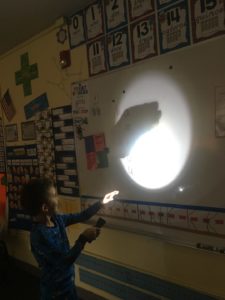 This week we had a great time learning in our new Sombras unit. The stories provided us with great information on different light sources and how shadows and shade are formed. We talked about and practiced how the position of the light (flashlight, lamp, sun, etc.) from the landing surface will change the size and shape of the shadow.
This week we had a great time learning in our new Sombras unit. The stories provided us with great information on different light sources and how shadows and shade are formed. We talked about and practiced how the position of the light (flashlight, lamp, sun, etc.) from the landing surface will change the size and shape of the shadow.
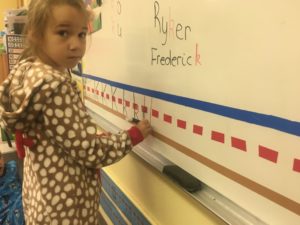
Tall letters touch the sky. Every letter sits on the ground and touches the fence in the middle.
Our weekly objectives were to:
- correctly identify and write the upper and lower case letters: Kk, Ll and Mm
- read, write and form the sight words: bebé, papá, mamá
- write using lines to correctly form letters and words.
- ask and answer questions about a story.
- retell important facts from a non-fiction story.
- write a sentence in the weekly journal using a capital letter at the beginning and punctuation at the end.
- use the daily sight word in a complete sentence.
- understand the difference between a word, sentence fragment, and a complete sentence.
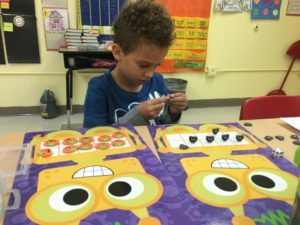
2 groups add together to make a larger number.
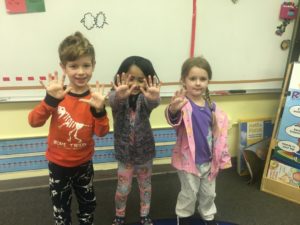
Making the number of the day: 25!
Las matemáticas
Everyone is doing a great job with the number identification, counting, counting on, and number formation.
Our weekly objectives were to:
- show various ways to form the number 5.
- use tens frames and dice to show how adding two numbers together forms a whole group.
- count on from given numbers and identify the following number.
- identify one more than and one less than a given number.
History & Geography
This week we began our next unit on Native Americans of North America. As an introduction we talked about who the first people were who lived on the continents of North and south America and how there are many, many different groups of these people called tribes. We looked at a map and identified North and South America as well as specific regions of the United States such as Northeast, Southeast, Southwest, and the Pacific Northwest.
Our objectives this week were:
• understand that Native Americans were the first inhabitants of North America
• explain that there are many tribes of Native Americans
• begin to contrast and compare your life to Native Americans with a focus on clothing, food, and shelter.
Science
This week we in our science domain we learned worked on a farm counting book and vegitable/ fruit identification and counting sheet. We also discussed and read about how seasons affect what happens on a farm.
Our objectives were to:
• describe a farmer’s job
• describe how farmers protect their crops from drought and pests
• sequence the seasonal rhythm of planting, growing, and harvesting
English Spelling/Writing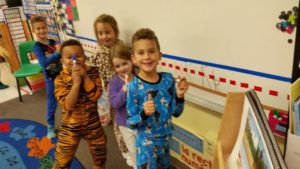
In our journals the class finished their farm and barn entry and had fun stamping different types of animals on to their page. about the farm. Our word wall words this week were: you, in, of. This week in spelling the red group got a new spelling sort on animals and the blue group is sorting “ad” family words.
Specialists:
Character Education with Ms. Jennie
This month we are focusing on the theme of responsibility. We are talking about what this means in practical terms and of course it includes everything from helping our parents/families and doing our schoolwork to taking responsibility for our mistakes by telling the truth, apologizing, and accepting the consequences (no excuses, blame-shifting, etc.). We have a fun little song to the tune of Mickey Mouse that helps us remember what responsibility looks like. We read the Aesop’s fable The Ant and the Grasshopper about the responsible ant who stored up food for the winter and the lazy grasshopper who lazed around instead. And then we’ll be reading Horton Hatches the Egg next week! We are focusing on how our actions have consequences!
by Ivary & Paola | Oct 5, 2018 | In The Loop
La Lectura
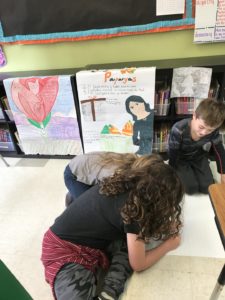
Club de lectores Esperanza renace
• Identify key characteristics of expository texts and different sources of media.
• Determine importance (main idea/supporting details) of the information presented for reading comprehension.
• Cite relevant evidence from the text to explain thinking, both in oral and written form.
• Analyze text, craft and structure of and interview.
• Integrate knowledge and ideas and make text-to-text connections.
• Correctly use the written accent according to the tonic accent in words at the grade level applying a systematic analysis. Palabras esdrujulas
• Read grade level poetry and prose orally with accuracy, appropriate rhythm and expression in progressive readings.
Students did a great job this week during our book club, Esperanza renace. Next Monday, they need to be ready to discuss: Las almendras, Las ciruelas y Las papas.
Ciencias
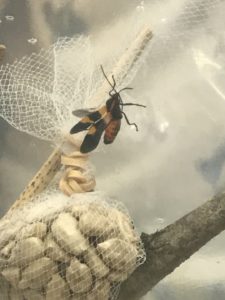 For several weeks students will observe and record events in the milkweed-bug habitats. Students should observe feeding and drinking, movement, mating, egg laying, hatching, and molting. After 8 weeks students should observe the completion of the milkweed-bug life cycle and see a multitude of offspring.
For several weeks students will observe and record events in the milkweed-bug habitats. Students should observe feeding and drinking, movement, mating, egg laying, hatching, and molting. After 8 weeks students should observe the completion of the milkweed-bug life cycle and see a multitude of offspring.
We continued the week developing answers for the following focus question: What are the defining characteristics of an individual, population, community, and ecosystem? Students used ecosystem sorting cards to reflect on organizing concepts in ecology and develop the vocabulary associated with those concepts. They were introduced to basic definitions used in ecological studies such as individual, population, community, ecosystem, and biotic/abiotic factors. They worked in groups to sort the picture cards into categories based on the definitions. Next week, we will be discussing the sorting activity and students will record their sorting results on a sheet.
• Observe milkweed bugs. Monitor changes that yield information about their life cycle and reproduction.
• Analyze and sort images on cards to determine which represent individuals, populations, communities, and ecosystems.
• Identify biotic and abiotic elements in an ecosystem.
• Accurately apply scientific terminology and vocabulary in oral and written form.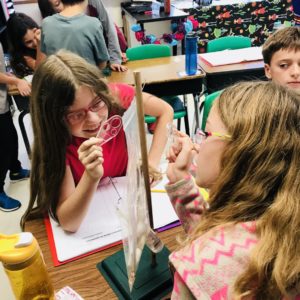
Mathematics
This week we began learning about Negative Numbers and the Number Line. Our objectives were:
- use negative numbers to represent real-world quantities
- represent, compare, and order positive and negative numbers on a number line
- understand the absolute value of a number as its distance from 0 on the number line
- interpret absolute value as magnitude for a positive or negative quantity in a real-world situation
Our test for Chapter 2 is on Monday!
History & Geography
This week we continued to learn about Ancient Greece and Rome. Our objectives were:
- understand aspects of Athenian democracy
- describe rights of citizens, women, slaves, and metics
- recognize the importance of education to Athenians
- understand the Spartan emphasis on military training, bravery, and warrior culture
- explain the Spartan system of government
- recognize some of the important differences between Athens and Sparta
English Writing & Spelling
Our objectives for writing were:
- explain the steps of the Writing Process and elements of narrative writing
- begin writing a Narrative piece by choosing a plot and theme
- continue pre-writing by understanding task, purpose, and audience
- create a graphic organizer that will guide the plot of our writing
Our Greek and Latin roots this week were:
- centr, center: middle
- chron, temp: time
- cid, cis: to cut or kill
- circ, circum: around
Our next Greek and Latin roots quiz will be on October 15th!
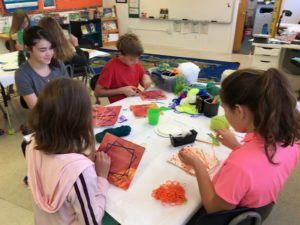 Specialists
Specialists
The 5th and 6th grade students finished their wonderful Yarn Stitchery projects which are on display on the bulletin boards at the end of the hallway. They did a great job combining painted texture with the strong linear designs of the yarn. I always wish we had more time to explore these projects further! This month the students will work on a 3 dimensional paper mâché’ Grecian Vase to go along with their social studies unit. And we’ll also learn some new techniques to create a Still Life of autumn produce from Tamra’s family garden. Many thanks to Barbara for helping out in the 5th/6th grade art class!
by Sarah Segall | Oct 5, 2018 | In The Loop
Pencils & Reading
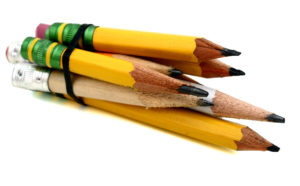 We have been very impressed with the responsibility shown by everyone! We will have a pencil ‘check-in’ on Thursday, October 11th. Students will be issued a new pencil, if needed. We are keeping track though and the top 5 students who keep their pencil for the longest time are in for some huge bragging rights and a special prize.
We have been very impressed with the responsibility shown by everyone! We will have a pencil ‘check-in’ on Thursday, October 11th. Students will be issued a new pencil, if needed. We are keeping track though and the top 5 students who keep their pencil for the longest time are in for some huge bragging rights and a special prize.
We also had our first 5 students start climbing our reading mountain. Ask your child what this means but there is a BIG prize at the end of every month for the students who make it to the top of the mountain by reading 12 hours in the month. (We keep track with the minutes you sign in their journal each week. Students go up a level after every 3 hours read.)
History & Geography
Our weekly objectives were to:
- Understand the changes that occurred in Europe after the fall of the Western Roman Empire.
- Understand the term Dark Ages.
- Identify Rome as the location of the pope and the center of the Roman Catholic Church.
- Identify the pope as the bishop of Rome.
- Understand that the Roman Catholic Church split in 1054.
- Identify St. Benedict of Nursia as the author of the Rule of St. Benedict.
- Describe life in a monastery.
- Understand ways monasteries affected life in Europe during the Middle Ages.
This week we went on a field trip to the Ape Caves and Lava Canyon! We learned that the bats at the Ape Caves had a disease called White Nose Syndrome. We also did two hikes. It was a great field trip.
By: Marisol
Mathematics w/Laura
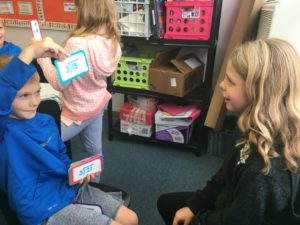 Whole Number Multiplication and Division
Whole Number Multiplication and Division
- Multiplying by a one digit number
- Multiplying by a two digit number
- Dividing by a one digit number (day 1)
We practiced (and quizzed each other using) multiplication and division flash cards. More practice at home, please!
HOMEWORK ALERT: Our next homework assignment is due Thursday, October 11th, as there is no school on Friday, October 12th.
Puzzles available for extra credit and Friday (Math) Bingo
Remember: MATH …. It’s everywhere!
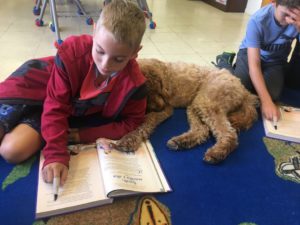
partner reading
La lectura
This week we completed our Sarah, sencilla y alta story. This historical fictions piece is full of realistic dialogue and winning characters to help the readers identify with the compelling story. Jacob Witting, the widowed father of Ana and Caleb, places an advertisement in a newspaper fora wife. Sarah Wheaton answers the advertisement. Through letters that travel across the continent from the shores of Maine to the western prairie, Sarah and the Witting family get to know each other. Finally, she agrees to travel west to see if she would like to live there.
Our weekly objectives were to:
- Explore the key concepts of: our need for human relationships cause us to take risks.
- Identify author’s point of view
- Identify and use personal pronouns
- Identify and use topic sentences (states the main idea of a paragraph and is usually stated at the beginning of a paragraph)
- Use the comprehension strategy: summarize the story as we read.
- Explore the structure of words, identify prefixes, suffixes and roots.
- Begin writing their autobiography using all their pre-writing notes to help them stay on topic and to write in a chronological order.
- Cursive practice of letters R and S.
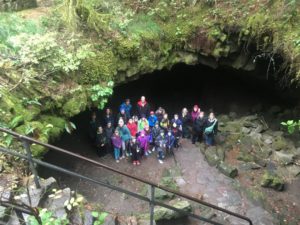
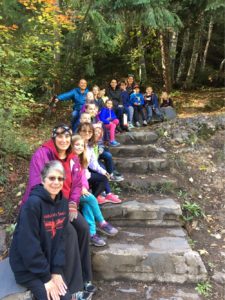 Ciencias
Ciencias
This was a very special week for us. Our class field trip to Mount Saint Helens was a great addition to our study of Soils, Rocks, and Landforms. In a few weeks we will be doing a case study of Mount Saint Helens.
Our weekly objectives were to:
- Explore physical changes in the earth’s surface.
- Identify changes that take place over a long period of time.
- Identify changes that happened rapidly.
- Identify sources of physical and chemical erosion while out in the ‘field’
- Complete our study of chemical weathering.
Specialists:
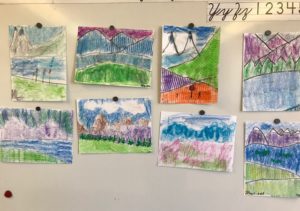 ART with Ms. Kelly
ART with Ms. Kelly
I hope you’ve enjoyed the students’ beautiful Backpack Drawings on the bulletin board. They did a great job making line drawings that created the illusion of actual 3-dimensional backpacks. Then they added tissue paper to create a fabric texture. The students also learned how to make Texture Rubbings and how to use them in a Mountain Landscape picture. I will probably save these pictures for the students to use later in the year. This month we’re going to learn about Medieval Illuminated Letters and the students will use their own initial as part of an Illuminated Letter Design.
by Jill & Sarah | Oct 5, 2018 | In The Loop
History & Geography
This week we had our own Diwali celebration. We made clay pot lanterns and decorated our black top with Rangoon designs using chalk. We also learned about the stories of how Buddha came to be and about King Asoka.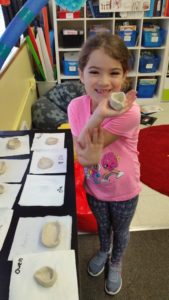
Our objectives
• understand how Prince Siddhartha became Buddha
• identify Buddhism
• listen to Buddhist Jataka Tale and understand it’s lesson
• identify King Asoka
• understand how Asoka spread Buddhism
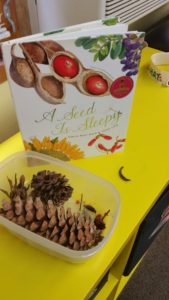 Science
Science
This week in our science domain Cycles in Nature, we continued to learn about trees. The class examined different kinds of seeds that come from trees and we made a diagram of the life cycle of an apple tree. On Friday we began learning about the life cycle of a chicken. The class had fun learning the song “Which Came First, The Chicken or the Egg?”
Our objectives were to:
• explain that a cycle is a sequence of events that repeats itself again and again
• explain the effects of seasonal changes on plants and animals
• define the term life cycle
• identify the stages of the life cycle of a tree.
•Identify different ways that trees spread their seeds
• explain the difference between deciduous and Evergreen trees.
• identify the stages of the life cycle of a chicken (egg to egg)
English Writing/Spelling
In our journals we used the idiom of the week, “Put your thinking cap on ” and we also wrote about the story of Buddha and the Tree of Life. For spelling we went over our practice test and reviewed the vowel patterns that we need to work on. Students who have a hundred percent on their practice test do not have to take the spelling test on Friday. Our word wall words this week were: because, before, best, beautiful
La lectura
This week we read La hora de cuentos: ¡Con la participación especial de Megan! Our objectives were:
- use the comprehension strategies making connections and making predictions when reading our story the first time
- use the comprehension skill Making Inferences when reading our story the second time
- learn and practice using possessive pronouns
- practice that gi and ge make the /h/ sound with our high-frequency words
Next week we will be reviewing all our high-frequency words that we have learned so far!
Las matemáticas
This week we finished our chapter on 3-Digit Addition. Our objectives were:
- add up to three-digit numbers with regrouping in the tens
- add up to three-digit numbers with regrouping in the ones and tens
- demonstrate our understanding of three digit addition on the chapter test
Specialists:
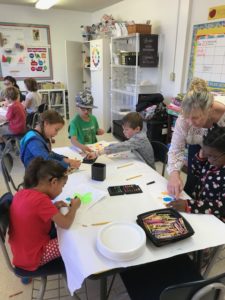 The students finished their beautiful Fall Landscape and Tree pictures, which had vivid colors and shapes similar to a stained glass window.
The students finished their beautiful Fall Landscape and Tree pictures, which had vivid colors and shapes similar to a stained glass window.
To go along with their study of India, the 1st and 2nd graders have been learning about Alpana artwork that is used in India during celebrations such as Diwali (Festival of Lights). The students learned how to fold paper to create guidelines on which to draw a symmetrical design. They are using neon oil pastels and watercolor to make some beautiful designs! (To be finished next week)
This month we’ll work on a Chinese Dragon picture. Other projects for October include drawing a painting a Pumpkin Still Life, and creating texture with Leaf Rubbings.
by Sarah Segall | Oct 5, 2018 | In The Loop
La lectura
This week we began our new language arts unit, Las sombras / the shadows. We read very detailed stories about how shadows are formed. Please send a labeled flashlight in with your child on Monday, which is also PJ day, so we can create out own shadows and effects in the classroom.
Our weekly objectives were to:
- recognize the difference between words and sentences
- correctly form upper and lowercase letters: Ff, Gg, Hh, Jj
- identify different types of sentences
- identify and use high frequency words in sentences and during reading: niño, niñas,
Las matemáticas
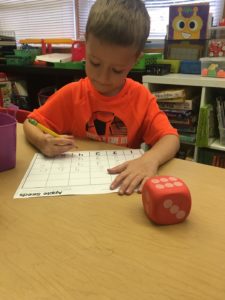
 This week we continued working on our number recognition, subtilizing (knowing the number of dice or objects immediately), counting, and forming groups of a given number.
This week we continued working on our number recognition, subtilizing (knowing the number of dice or objects immediately), counting, and forming groups of a given number.
Our weekly objectives were to:
- Count to the number of the day (the week ended on the 24th day of school)
- show the number that came before and the number that came after the number of the day (this was a new addition for some of our students in our daily morning binders)
- introduction to the number line and how to find the number that comes before and after a given number
- identify which number is greater than (el nùmero 5 es mayor que 2).
 History & Geography
History & Geography
This week we we finished up nursery rhymes and are now focusing on fables. We read The Lion and the Mouse, The Dog and His Reflection, and The Hare and The Tortoise. The class watched a short video of The Hare and The Tortoise.
Our objectives this week were:
• listen to and understand the fables and rhymes we have heard.
• describe the main characters
• retell the events
• identify repeating lines and rhyming words
• recite the nursery rhymes that we have learned
• understand that fables often have animal characters that act like people
• understand that fables teach a lesson that is stated as the moral
• identify the moral of the fable
Science
This week we in our science domain we learned about all kinds of crops on the farm. The students named their favorite foods that come from farms. We talked about what parts of plants fruits, vegetables, grain, and nuts can come from. We also read revisited the story The Little Red Hen and practiced acting it out.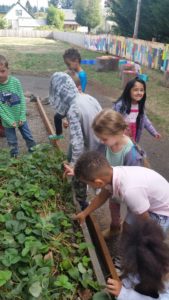
Our objectives were to:
• describe the farmers job
• explain why farmers grow crops
• identify crops as plants grown on farms for use as food
• describe how some food comes from farms as crops
• identify wheat as a crop grown on farms for uses food
• identify bread as a product from wheat
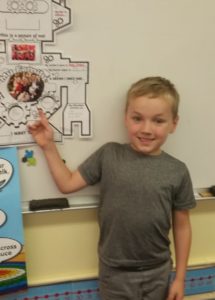
Our special person and birthday boy!
English Spelling and Writing
In our journals the class used some of their Word Wall words to write a sentence about the farm. We learned the color song “Orange”. Our word wall words this week were: he, and, one, on, orange. This week we began our spelling program. The green group is working on picture sorting fruit and not fruit and the blue group is working on “at” family words.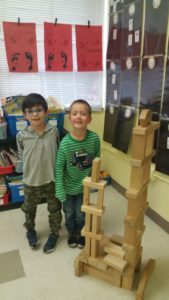
Specialists:
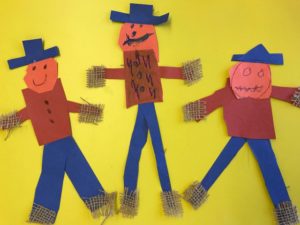 The K-1 class has been busy learning about line and shape. After learning how to draw different types of line, the students used lines to draw and paint a Fall Landscape. The students also learned how to cut out basic shapes to create some fun Scarecrow Pictures. They are doing a great job learning how to follow directions in the art room!
The K-1 class has been busy learning about line and shape. After learning how to draw different types of line, the students used lines to draw and paint a Fall Landscape. The students also learned how to cut out basic shapes to create some fun Scarecrow Pictures. They are doing a great job learning how to follow directions in the art room!
For October, we are planning to make some Robot projects, with help from Aries’ and Acelin’s dad, Fernando. The students will also practice mixing primary colors to create secondary colors for a Pumpkin Picture, and we’ll hopefully have time for an Owl Drawing.
by Sarah Segall | Sep 30, 2018 | In The Loop
Fall FUN is around the corner!
School Spirit week!

Monday October 8th – Pajama Day!
Tuesday October 9th – School Color Day
Wednesday October 10th – Crazy Hair Day
…all leading up to:
SWS Great Pumpkin Run
Thursday October 11th 1:45pm
Wear your running shoes, bring your water bottle, and get ready to RUN! Raise money for terrific improvements and activities at our school!
by Ivary & Paola | Sep 28, 2018 | In The Loop
La Lectura
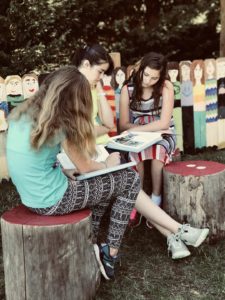
Students during shared reading.
The focus of Literacy this week was on historical fiction. We read the selection Las casi siempre verdaderas aventuras the Homer P. Figg, by Rodman Philbrick. It was such a moving story from the perspective of a 12 year old child who has to deal with very challenging life events. Students did a great job making meaningful connections and participating in the analysis of the text. Some of the objectives this week included:
- Identify key characteristics of historical fiction.
- Cite relevant evidence from the text to make contributions to our discussions.
- Accurately answer comprehension questions in written form. Share answers.
- Describe how a particular story or the plot of a text takes place in a series of episodes.
- Describe how the characters respond or change as the plot unfolds
- Analyze how a particular sentence, chapter or scene fits the overall structure in a text and how it contributes to the development of the theme, setting or plot.
- Correctly use the written accent according to the tonic accent in words at the grade level applying a systematic analysis. (Palabras graves)
- Identify subject and predicate in a sentence.
- Correctly use commas and conjunctions in a sentence or paragraph.
We were so busy this week we run out of time for our book club discussion (this usually takes place on Fridays), so we will be having this on Monday. Be ready to participate! Also, be ready for our grammar quiz!
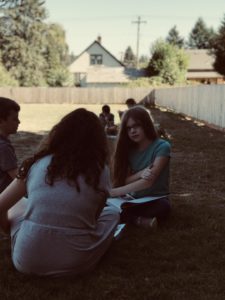
Students during shared reading.
Ciencias
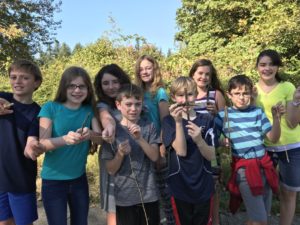
Collecting twigs for our milkweed bug habitats.
During this investigation, students raise milkweed bugs in a supportive habitat to study the insect’s reproductive biology. The information from this study is used to study milkweed-bug population dynamics in future studies. Students are introduced to adult milkweed bugs in petri dishes. Students observed the milkweed bugs carefully and discussed their notables characteristics. Students followed directions of how to create and habitat for our milkweed bugs. They will be recording their observations during the next couple weeks. .
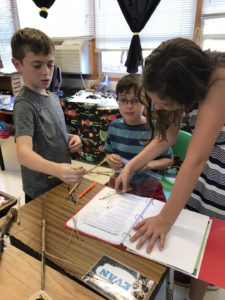
Students closely following step by step directions of “how to make a bug habitat” in Spanish!
Mathematics
This week we finished our first math chapter! Our objectives were:
- the cube of a number a is a x a x a
- the cube root of a number a is the number whose cube is a
- review concepts learned during this chapter
- demonstrate understanding on the chapter test
History & Geography
This week we complete our unit on World Deserts and began our unit on Ancient Greece and Rome. Our objectives were:
- review the information learned this chapter by playing Quiz Show
- complete the unit test
- understand the social organization of Greek City-States that share a common language and religion
- identify tyranny, aristocracy, oligarchy, and democracy as early forms of Greek government
English Writing & Spelling
Our objectives for writing were:
- understand how and when to use transition words in paragraphs
- know and use the 4 types of closing sentences at the end of paragraphs
- take the paragraph/sentence quiz
- know the 6 steps of the writing process
Our Greek and Latin Roots this week were:
- bio: life
- capit/cipit: head
- carne: meat/flesh
- ceipt/ cept/ ceit/ ceiv: to take hold/seize
Our greek and latin roots quiz is on Monday!
Specialists
Music
In September we worked on rhythm – note and rest counting, recognition, writing, and playing. We reviewed the dynamics that we learned last year, ranging from very soft (Pianissimo) to very loud (Fortissimo). We practiced working together in groups to carry a beat, and how write out rhythm patterns by ear.
In October we will delve into tonality by singing melodies, introducing harmony, and identifying major and minor chords. We will connect rhythm and melodic elements by playing the xylophone. We will also review vocal ranges Soprano, Mezzo Soprano, Alto, Tenor, Baritone, and Bass; and we will improve melodic and harmonic singing skills.
by Sarah Segall | Sep 28, 2018 | In The Loop
Please be sure to have your child record their daily reading minutes in their planner and sign their minutes. We will begin our class reading challenge next week.
 Also, ask your child about our Great Pencil Challenge! (We are still looking for a volunteer to come in during pick-up time each day to sharpen pencils.)
Also, ask your child about our Great Pencil Challenge! (We are still looking for a volunteer to come in during pick-up time each day to sharpen pencils.)

Learning how to search text and use context for answers.
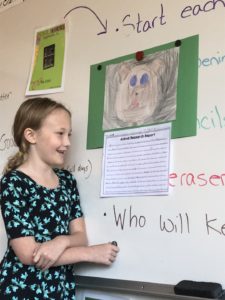
Sharing our mountain animal reports.
History & Geography
Our weekly objectives were to:
- Identify the date A.D. 476 as the fall of the Western Roman Empire
- Understand internal causes of Rome´s decline and fall
- Understand how Goths, Vandals, Huns and other non-Roman tribes contributed to Romeś decline and fall
This week our newsletter contributors are:
Reporter- Kate
Editor- Miria
Photographer- Luke
Field Trip Reminder
We have our field trip to Mt. St. Helens on Tuesday, October 2nd. We will meet in the parking lot of SWS at 7:45 a.m.
Please make sure you dress appropriately for the weather and hiking. Also bring warm enough clothes for our cave tour- it will be cold!
Please bring a headlamp or flashlight- the brighter the better! New batteries plus back up batteries suggested!
Bring a packed lunch and snack.
Mathematics w/Laura

Estimation and Number Theory
- · Multiply using (area) models
- · Real world problem solving (word problems)
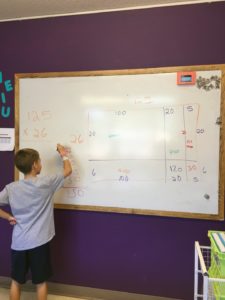
- · tChapter 2 assessment completed on Friday, September 28th
Remember to practice multiplication facts through 12 times 12
Puzzles available for extra credit and Friday (Math) Bingo
Remember: MATH …. It’s everywhere!
La lectura
This week we worked quite a bit on planning to write and exploring words that help us become better readers and better writers. We also worked on different strategies to help us while reading.

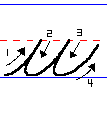

 Our weekly objectives were to:
Our weekly objectives were to:
- Identify and use time and order words to help understand the order in which events occur.
- Identify and use place and location words to help show spatial order in reading and writing.
- Create a time line to organize information in chronological order.
- Review how all cursive letters are made of the four basic types of strokes (under, down and over curves, and slant lines-to the right).
- Review cursive u, w, and b.
- Introduce cursive u and w.
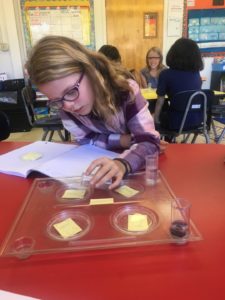
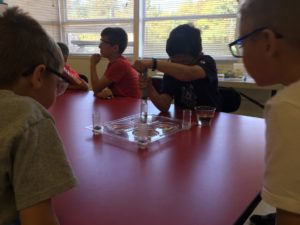
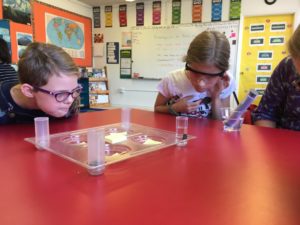 Ciencias
Ciencias
This week we started a great investigation on chemical weathering. We planned and conducted an investigation to test rocks for interaction with “acid rain.” We could see some rocks (limestone and marble) are very susceptible to acid rain, one form of chemical weathering, but other rocks (basalt and sandstone) are unaffected.
Our weekly objectives were to:
- Develop and use models
- Plan and carry out investigations
- Analyze and interpret data
- Construct explanations
- Obtain, evaluate, and communicate information
- Understand that weathering is the breakdown of rocks and minerals at or near the Earth’s surface.
- Understand that chemical weathering occurs when exposure to water and air changes rocks and minerals into something new.
Specialists:
Music
In September we worked on rhythm – note and rest counting, recognition, writing, and playing. We also reviewed the dynamics loud and soft (Forte and Piano) that we learned last year, and learned new dynamic markings ranging from very soft (Pianissimo) to very loud (Fortissimo).
In October we will delve into tonality by singing melodies, introducing harmony, and listening for major and minor sounds. We will connect rhythm and melodic elements by playing the xylophone. We will also learn about vocal ranges Soprano, Mezzo Soprano, Alto, Tenor, Baritone, and Bass.
by Jill & Sarah | Sep 28, 2018 | In The Loop
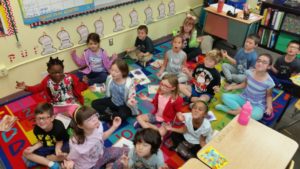
Yoga
History & Geography
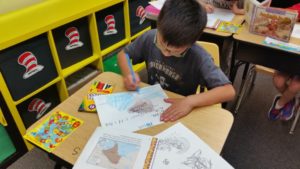
Making maps
This week we learned more about ancient India. The class discussed the first civilizations of India and drew and labeled a map of ancient India, including important geographical features. We learned about the 3 important gods of Hinduism: Brahma, Vishnu, and Shiva, and what they represent. The class was eager to practice some yoga poses and had fun learning about the Festival of Lights, Diwali.
Our objectives:
• understand the Aryan invasion of ancient India
• identify Hinduism as an important world religion
• recognize popular Hindu customs
• understand the importance of the Ganges River
• identify Diwali, the Festival of Lights
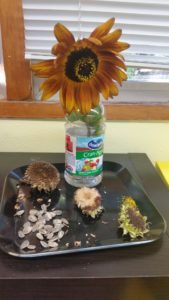 Science
Science
This week in our science domain Cycles in Nature, we learned about the life cycle of a tree. The students went on a walk around the school and looked at different types and stages of trees. They made a Venn diagram comparing and contrasting the life cycle of trees to sunflowers. We also read the book “The Giving Tree” and had a class discussion about the cycles that were included in this story.
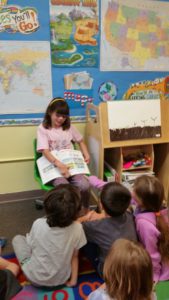
Sharing science from home
Our objectives were to:
• explain that a cycle is a sequence of events that repeat itself again and again
• explain the effects of seasonal changes on plants and animals
• define the term life cycle
• identify the stages of the life cycle of a tree and compare and contrast it to the life cycle of a sunflower.
Spelling and Writing
In our journals we used the idiom of the week, ” I’m all ears” and wrote about what topics of conversation keep our attention. I met with both spelling groups this week to go over their new sorts. We had a practice test on Friday.
La lectura
This week we read la biblioteca.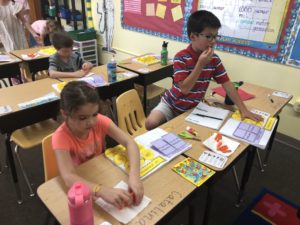
Our weekly objectives were to:
- use the comprehension strategies making connections and making predictions while we read the story the first time
- use the comprehension skill Drawing Conclusions while we read the story the second time
- recognize the /g/ spelling for the letter g
- learn and practice using action verbs
Our PUF for next week are: dice, cerca, cinco, salt, suben, sábado
Las matemáticas
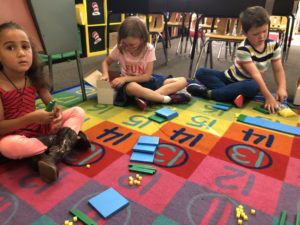 This week we took our first math test and began Chapter 2: Addition up to 1,000. Our weekly objectives were to:
This week we took our first math test and began Chapter 2: Addition up to 1,000. Our weekly objectives were to:
- use base-ten blocks to add numbers without regrouping
- use base-ten blocks to add numbers with regrouping in the ones
- add up to three-digit numbers without regrouping
- add up to three-digit numbers with regrouping in the ones
Specialists:
Music:
In September we worked on rhythm – note and rest counting, recognition, writing, and playing. We also reviewed the dynamics loud and soft (Forte and Piano) that we learned last year.
In October we will delve into tonality by singing melodies, introducing harmony, and listening for major and minor sounds. We will connect rhythm and melodic elements by playing the xylophone. We will also learn about the composer Antonio Vivaldi, and hear the music he wrote for the Autumn season!
 This week we had a great time learning in our new Sombras unit. The stories provided us with great information on different light sources and how shadows and shade are formed. We talked about and practiced how the position of the light (flashlight, lamp, sun, etc.) from the landing surface will change the size and shape of the shadow.
This week we had a great time learning in our new Sombras unit. The stories provided us with great information on different light sources and how shadows and shade are formed. We talked about and practiced how the position of the light (flashlight, lamp, sun, etc.) from the landing surface will change the size and shape of the shadow.







 Specialists
Specialists We have been very impressed with the responsibility shown by everyone! We will have a pencil ‘check-in’ on Thursday, October 11th. Students will be issued a new pencil, if needed. We are keeping track though and the top 5 students who keep their pencil for the longest time are in for some huge bragging rights and a special prize.
We have been very impressed with the responsibility shown by everyone! We will have a pencil ‘check-in’ on Thursday, October 11th. Students will be issued a new pencil, if needed. We are keeping track though and the top 5 students who keep their pencil for the longest time are in for some huge bragging rights and a special prize. Whole Number Multiplication and Division
Whole Number Multiplication and Division

 Ciencias
Ciencias ART with Ms. Kelly
ART with Ms. Kelly

 The students finished their beautiful Fall Landscape and Tree pictures, which had vivid colors and shapes similar to a stained glass window.
The students finished their beautiful Fall Landscape and Tree pictures, which had vivid colors and shapes similar to a stained glass window.
 This week we continued working on our number recognition, subtilizing (knowing the number of dice or objects immediately), counting, and forming groups of a given number.
This week we continued working on our number recognition, subtilizing (knowing the number of dice or objects immediately), counting, and forming groups of a given number.



 The K-1 class has been busy learning about line and shape. After learning how to draw different types of line, the students used lines to draw and paint a Fall Landscape. The students also learned how to cut out basic shapes to create some fun Scarecrow Pictures. They are doing a great job learning how to follow directions in the art room!
The K-1 class has been busy learning about line and shape. After learning how to draw different types of line, the students used lines to draw and paint a Fall Landscape. The students also learned how to cut out basic shapes to create some fun Scarecrow Pictures. They are doing a great job learning how to follow directions in the art room!











 Our weekly objectives were to:
Our weekly objectives were to:

 Ciencias
Ciencias




